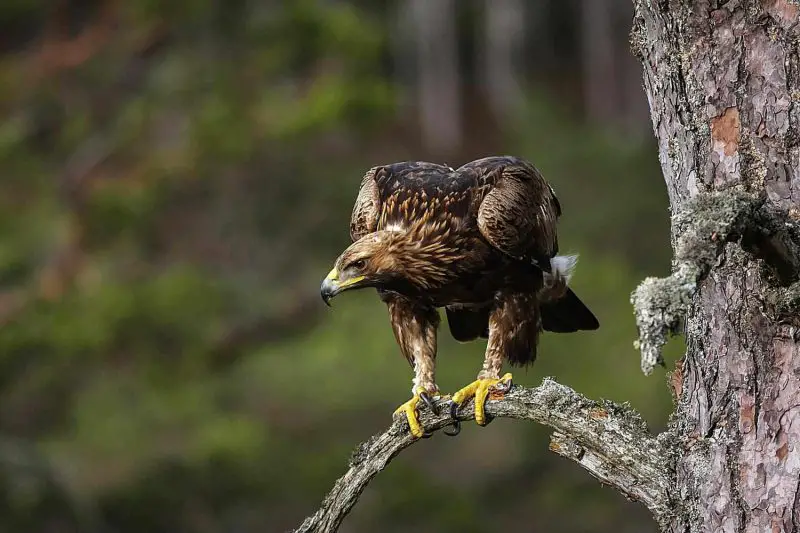Arizona’s diverse landscapes are home to some of the most impressive birds of prey in the country. Eagles, with their striking size and powerful presence, are among the most fascinating to observe. This article highlights three eagle species found in Arizona.
The Bald Eagle, known for its iconic white head, visits Arizona during winter months, while the Golden Eagle is a permanent resident soaring across the state’s deserts and mountains. The Common Black Hawk, often mistaken for an eagle, also makes its home near Arizona’s waterways.
Bird enthusiasts and nature lovers alike will find useful identification tips and interesting facts about these magnificent raptors and their roles in Arizona’s ecosystems.
Common Eagles Found in Arizona
Bald Eagle (Haliaeetus leucocephalus)

The Bald Eagle is one of the most iconic birds of prey in North America, instantly recognizable by its striking white head and tail feathers contrasted against a dark brown body and wings. Adult Bald Eagles have bright yellow eyes, beak, and feet, which stand out vividly against their plumage. Juveniles are mostly dark brown with mottled white patches and do not acquire their full white head and tail until around 4 to 5 years of age. Their massive wingspan ranges between 1.8 and 2.3 meters (6 to 7.5 feet), making them one of the largest raptors in Arizona.
In Arizona, Bald Eagles are primarily winter visitors, migrating south from northern regions to take advantage of the state’s milder climate and abundant water bodies. They are most often spotted near large lakes, reservoirs, and river systems such as the Salt River, Lake Mead, and the Colorado River. These areas provide ample fishing opportunities, which are the Bald Eagle’s preferred food source. Occasionally, they may also scavenge or prey on waterfowl and small mammals.
Their hunting technique involves soaring high over water, using their sharp eyesight to spot fish near the surface. Once a target is located, the eagle executes a powerful, swift dive, snatching fish with its strong talons just below the water’s surface. They are also opportunistic feeders, sometimes stealing prey from other birds or feeding on carrion. Bald Eagles are known for their impressive nests, often built atop tall trees or cliffs, which can reach enormous sizes over the years.
The habitat of Bald Eagles in Arizona is closely tied to availability of water and fish. Protected natural areas, such as the Riparian zones along the Verde and Gila Rivers and wildlife refuges, offer safe breeding and roosting grounds. While they are not year-round residents, their seasonal presence is an important indicator of the health of Arizona’s aquatic ecosystems.
Golden Eagle (Aquila chrysaetos)

Golden Eagles are large and powerful raptors known for their rich brown plumage with striking golden feathers on the nape and neck, which gives them their name. Their eyes are a piercing amber, and their beaks are strong and hooked, perfectly adapted for tearing flesh. With a wingspan of about 1.8 to 2.2 meters (6 to 7.2 feet) and weighing between 3 and 6.5 kilograms (6.6 to 14.3 pounds), they are among the largest birds of prey in the American Southwest, including Arizona.
Unlike the Bald Eagle, Golden Eagles are permanent residents throughout Arizona and prefer open landscapes such as deserts, grasslands, and mountainous regions. They are frequently observed in the high desert areas and mountain ranges like the Mogollon Rim and the San Francisco Peaks. These eagles are apex predators, hunting a variety of mammals including rabbits, squirrels, prairie dogs, and occasionally larger prey such as young deer or coyotes.
Golden Eagles are skilled hunters that use a combination of soaring flight to locate prey and sudden, high-speed dives to capture it. Their strong talons and powerful beaks allow them to subdue prey quickly. They often hunt from perches or while flying low over open ground. Their diet and hunting style make them well-adapted to the rugged and arid environments of Arizona, where food availability can be patchy.
Golden Eagles nest on cliffs, rocky outcrops, or tall trees in remote locations, often returning to the same nesting sites for years. Their nests, called eyries, can be enormous, made of sticks and lined with softer materials. The presence of Golden Eagles in Arizona is a vital part of the ecosystem, controlling populations of small to medium-sized mammals and maintaining a natural balance.
Common Black Hawk (Buteogallus anthracinus)

Though technically a hawk, the Common Black Hawk is often mistaken for a small eagle because of its robust build and striking appearance. It has predominantly black plumage with broad, rounded wings and a short tail featuring distinctive white bands. The bird measures around 45 to 58 centimeters (18 to 23 inches) in length, with a wingspan of approximately 1.1 meters (3.6 feet). Its strong legs and hooked beak make it well suited for catching a variety of prey.
In Arizona, the Common Black Hawk is closely associated with riparian habitats in the southern and central parts of the state. It thrives near rivers, streams, and wooded canyons where water is available year-round. This environment provides the black hawk with abundant food sources such as reptiles, amphibians, crustaceans, small mammals, and occasionally fish. It tends to hunt from low perches or by flying low over water and dense vegetation.
The hunting behavior of the Common Black Hawk is opportunistic and patient. It often waits silently on a branch or rock near water, then swoops down to seize prey with its sharp talons. It may also wade into shallow water to catch aquatic animals. Unlike the soaring and diving techniques seen in Bald and Golden Eagles, this hawk relies more on stealth and short flights to catch prey.
Common Black Hawks build bulky nests made of sticks in tall trees near watercourses, often reusing the same nest each breeding season. Their dependence on riparian zones makes them a good indicator species for the health of Arizona’s waterways. Conservation of these habitats is critical for the survival of the Common Black Hawk in the region.
FAQs About Eagles in Arizona
What species of eagles are found in Arizona?
Arizona is home to two true eagle species: the Bald Eagle (Haliaeetus leucocephalus) and the Golden Eagle (Aquila chrysaetos). Additionally, the Common Black Hawk (Buteogallus anthracinus), though technically a hawk, is often grouped with large raptors seen in Arizona.
When can you see Bald Eagles in Arizona?
Bald Eagles are primarily winter visitors in Arizona. They usually migrate south from northern regions between November and March to take advantage of Arizona’s milder climate and abundant fishing opportunities near lakes and rivers.
Are Golden Eagles year-round residents of Arizona?
Yes, Golden Eagles are permanent residents and can be seen throughout the year across various habitats in Arizona, including mountains, deserts, and open grasslands.
What do Bald Eagles eat in Arizona?
Bald Eagles mainly feed on fish, which they catch near lakes, rivers, and reservoirs. They also opportunistically prey on waterfowl, small mammals, and occasionally scavenge carrion.
How do Golden Eagles hunt their prey?
Golden Eagles use their exceptional eyesight to spot prey from high in the sky, then dive rapidly to capture mammals such as rabbits, squirrels, and prairie dogs using their powerful talons.
Where do Common Black Hawks live in Arizona?
Common Black Hawks are typically found in riparian habitats—areas near rivers, streams, and wooded canyons—in southern and central Arizona, where water and prey are abundant.
What is the size difference between Bald Eagles and Golden Eagles?
Both species have similar wingspans ranging from 1.8 to 2.3 meters. However, Bald Eagles often appear bulkier due to their large white heads and necks, while Golden Eagles have more uniform brown and golden plumage.
How can you identify juvenile Bald Eagles?
Juvenile Bald Eagles lack the distinctive white head and tail feathers of adults and have mostly dark brown plumage with mottled white patches. They develop the iconic white feathers after about 4 to 5 years.
Are any eagle species endangered in Arizona?
Bald Eagles were once endangered but have made a significant recovery thanks to conservation efforts. Both Bald and Golden Eagles are now protected under federal laws, including the Bald and Golden Eagle Protection Act.
What is the best time and place to observe eagles in Arizona?
Winter months near large lakes, reservoirs, and river systems offer good chances to see Bald Eagles. Golden Eagles can be observed year-round in open desert and mountainous areas. Wildlife refuges and protected natural parks provide ideal eagle-watching locations.






